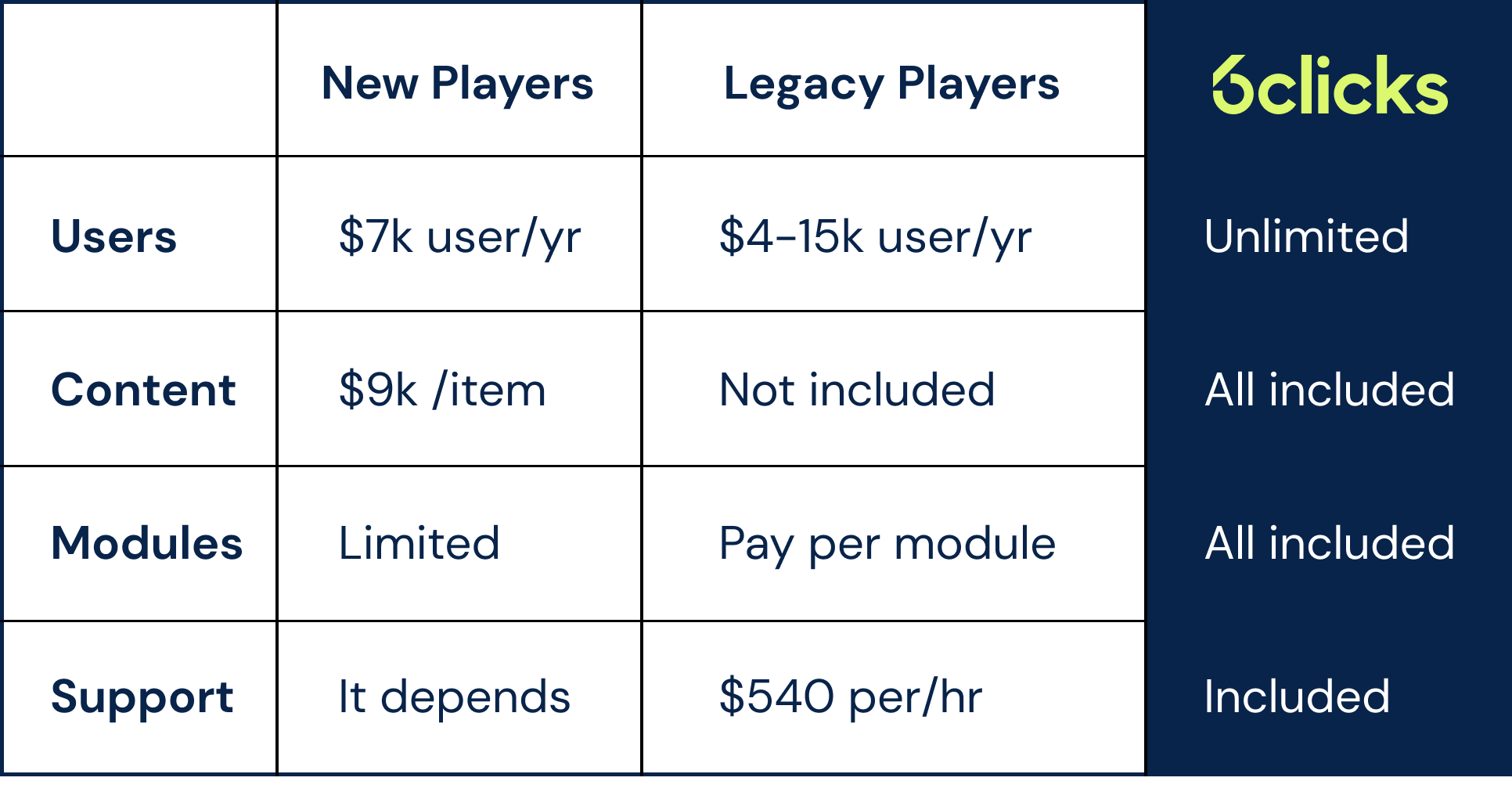
Governance, Risk & Compliance (GRC) software pricing guide and vendor comparison
When considering the purchase of Governance, Risk & Compliance (GRC) software, it is important to not only focus on the initial price, but also to understand the total cost of ownership. The total cost of ownership encompasses all expenses associated with owning and operating the software over its lifetime. By conducting a thorough analysis of the total cost of ownership, businesses can make more informed decisions and avoid any unexpected financial burdens down the line.
The concept of total cost of ownership in relation to GRC software pricing takes into account various factors. These factors include the upfront purchase price, implementation costs, ongoing maintenance and support fees, training costs, and any necessary hardware or infrastructure upgrades. Additionally, businesses should consider the impact on productivity and efficiency, as well as potential savings in terms of time and resources.
By fully understanding the total cost of ownership, businesses can more accurately evaluate the value proposition of different GRC software options. This analysis allows organizations to not only compare pricing plans, but also to consider the long-term benefits and return on investment (learn about the 10 provided by each solution.
What do you get when you buy GRC software?
When you buy GRC (Governance, Risk, and Compliance) software, what you get depends on the specific vendor and product you choose. GRC software is designed to help organizations streamline and manage their governance, risk management, and compliance processes more effectively. The software typically offers a range of features and functionalities to address these areas.
Here are some common features or the suite of tools you might find in GRC software:
-
Risk assessment: GRC software assists in identifying and assessing risks across different areas of the organization. It may include tools for conducting risk assessments, defining risk appetite, and prioritizing risks based on their potential impact.
-
Risk mitigation and control: The software may offer functionalities to develop risk mitigation strategies and controls. It helps in tracking the implementation of risk responses and monitoring their effectiveness.
-
Compliance management: GRC software often includes modules to manage compliance with various regulations, industry standards, and internal policies. It helps organizations track compliance requirements, certifications, and deadlines.
-
Incident management: This feature helps organizations handle incidents and breaches efficiently. It allows for the logging, tracking, and resolution of incidents, ensuring timely responses to potential risks.
-
Reporting and analytics: GRC software typically provides reporting and analytics capabilities to generate customized risk and compliance reports, performance metrics, and key risk indicators.
-
Workflow and collaboration: GRC software may include workflow automation to streamline risk assessment processes and improve collaboration among different teams involved in risk management.
-
Audit management: Some GRC solutions include audit management features, enabling organizations to schedule, conduct, and track internal audits effectively.
-
Policy management: This feature helps organizations in creating, updating, and managing policies across the enterprise, ensuring compliance with regulations and industry best practices.
-
Vendor risk management: For organizations dealing with third-party vendors and suppliers, GRC software may offer tools to assess and manage vendor-related risks.
-
Integration capabilities: Depending on the software, integration with other systems like ERP (Enterprise Resource Planning) and CRM (Customer Relationship Management) may be supported to enhance data sharing and analysis.
This is just some of the features and capability you can expect with GRC software. If you are looking for a more comprehensive GRC evaluation guide, click here. Alternatively, if you need a toolkit of templates for RFPs, RFI or vendor quick assessment, go here.
It's important to note that GRC software can range from comprehensive, all-in-one solutions to more specialized tools focusing on specific areas within governance, risk, and compliance. When purchasing GRC software, it's essential to carefully evaluate your organization's needs and requirements, and consider factors like scalability, user-friendliness, security, and ongoing support provided by the vendor.
How much does GRC software cost?
When it comes to the cost of Governance, Risk & Compliance (GRC) software, it can vary significantly depending on several factors. The pricing range for GRC software can be anywhere from a few thousand dollars to hundreds of thousands of dollars, depending on the complexity of the organization's needs and the specific features and functionalities required.
Several factors influence the pricing of GRC software. One major factor is the size and complexity of the organization. Larger enterprises with multiple departments and complex regulatory requirements may require a more robust and tailored solution, which can result in higher costs. Additionally, the number of users and the level of customization needed can also impact the price. Not all vendors price in the same way though - learn more here.
Different vendors have varying price points for their GRC software. Some may offer a basic package at a lower price point, while others provide more advanced features and additional modules that come at a higher cost. It's important to carefully evaluate the features and functionalities included in each price plan to ensure they align with the organization's specific needs.
In addition to the software itself, there are often additional costs associated with professional services. These can include implementation and integration services, data migration, training, and ongoing support. These services can add to the overall cost of implementing and maintaining the GRC software.
Our research has shown, that with some vendors, particularly the legacy (older) ones, the cost of the licensing can be just 20% of the total cost of ownership. You need to know what you are buying.
GRC software total cost of ownership
Implementing and maintaining GRC software involves more than just the upfront costs of purchasing the software itself. Organizations also need to consider the total cost of ownership (TCO), which includes various factors such as implementation, integration, training, and ongoing support. These additional costs can significantly impact the overall investment required for effective GRC software utilization. To make informed decisions and accurately budget for GRC software, organizations need to carefully evaluate the TCO and consider factors such as the size and complexity of the organization, the number of users, customization requirements, and the level of professional services needed. By understanding the TCO, organizations can make more cost-effective and efficient decisions regarding their GRC software implementation and ongoing maintenance.
What does the total cost of ownership mean?
Total cost of ownership refers to the overall expenses associated with the implementation and maintenance of GRC software, beyond just the initial licensing costs. When considering GRC software pricing, it is crucial to understand that the total cost of ownership includes various factors such as setup costs, ongoing maintenance and support fees, as well as any additional expenses related to the software implementation.
Licensing costs are the upfront fees paid for the software, but they are only a part of the total cost. Setup costs include the expenses incurred during the initial installation and configuration of the software, including training and data migration. Ongoing maintenance fees cover updates, bug fixes, and user support provided by the software vendor.
In addition to these costs, it is important to consider any additional expenses that may arise during the implementation process. This could include hiring consultants or IT professionals to assist with the deployment, as well as potential integration costs with existing systems.
By considering the total cost of ownership, organizations can have a more accurate understanding of the financial impact of implementing GRC software. It allows them to make informed decisions based on the complete picture of costs associated with the software solution, ensuring that there are no surprises later on and enabling better budgeting and planning.
How do you measure the total cost of ownership?
When evaluating the total cost of ownership for GRC software, it is essential to consider more than just the pricing and licensing fees. The total cost of ownership encompasses all the direct and indirect expenses incurred over the software's lifespan.
Pricing includes the upfront fees and ongoing licensing costs. However, it is crucial to also factor in setup costs, such as installation, configuration, training, and data migration. These expenses are incurred during the initial implementation.
Maintenance fees are another component of the total cost of ownership. These cover updates, bug fixes, and user support provided by the software vendor. It is important to understand the vendor's service level agreement to determine ongoing maintenance expenses.
Additionally, there may be extra costs associated with the implementation process. This could include hiring consultants or IT professionals to assist with deployment and potential integration costs with existing systems.
By considering pricing, setup costs, licensing fees, and any additional expenses related to implementation and maintenance, organizations can accurately gauge the total cost of ownership for GRC software. This holistic approach ensures that the true cost of adopting and maintaining the software is accounted for before making a purchasing decision.
What are the drivers of GRC software total cost of ownership
The total cost of ownership for GRC software is influenced by various factors, commonly referred to as drivers. These drivers contribute to the overall expenses associated with implementing and maintaining GRC software. Key drivers of GRC software total cost of ownership include:
- Software Licensing Fees: GRC software typically involves upfront licensing costs, which are determined based on factors such as the number of users and the specific features required. These fees vary among different software vendors and may be a significant contributor to the overall cost.
- Professional Services Costs: To ensure a smooth implementation and configuration process, organizations may require professional services such as consulting, training, and customization. These services are aimed at tailoring the software to meet specific business requirements. The fees charged by service providers should be considered when calculating the total cost of ownership.
- Ongoing Maintenance Fees: GRC software vendors typically offer maintenance and support services, which may incur recurring fees. These fees cover updates, bug fixes, user support, and system enhancements. It is important to understand the vendor's maintenance and support terms to estimate ongoing expenses accurately.
Other drivers that may influence the total cost of ownership for GRC software include customization fees for adapting the software to unique business needs, potential integration costs with existing systems, and any additional features or modules required. By considering these drivers, organizations can make informed decisions regarding the total cost of ownership for GRC software implementation.
What to watch out for with GRC software licensing
When it comes to GRC software licensing, there are several potential pitfalls and considerations that organizations need to be aware of.
Firstly, it's important to carefully review the licensing terms and conditions provided by the software vendor. Some vendors may have complex licensing models with different tiers and usage restrictions, which can make it difficult to accurately estimate costs. Additionally, organizations should be cautious of any hidden fees or unexpected charges that may arise during the licensing process.
Another consideration is scalability. As the organization grows or its GRC needs evolve, additional licenses may be required. It's important to assess the flexibility of the licensing model and whether it allows for easy scalability without incurring excessive costs.
Furthermore, organizations should consider the type of license they need. Some vendors offer named user licenses, which are tied to specific individuals, while others provide concurrent licenses, allowing multiple users to access the software simultaneously. Understanding the specific requirements of the organization and choosing the right license type is crucial to avoiding unnecessary expenses.
Lastly, organizations should factor in potential maintenance fees. GRC software vendors often charge ongoing fees for maintenance and support services. It's important to carefully review the vendor's maintenance and support terms to understand the cost implications and what services are covered.
Overall, by being aware of these potential pitfalls and considerations, organizations can better navigate the licensing process and ensure that the costs associated with GRC software licensing are effectively managed.
What approach do the different vendors take in pricing their software?
Different vendors take varying approaches in pricing their GRC software. Pricing models can range from subscription-based to perpetual licensing and may be influenced by factors such as the number of users, modules required, and the size of the organization.
Vendors often offer different tiers of pricing to cater to the needs of organizations of different sizes. These tiers may include basic, standard, and enterprise options, each with different features and capabilities.
Customization options also play a major role in pricing. Some vendors offer the flexibility to customize the software to meet specific organizational needs, while others provide a more standardized solution. Customization may require additional fees or professional services to tailor the software to the organization's specific requirements.
Additional costs beyond the initial licensing fees may include ongoing maintenance and support fees, as well as costs associated with implementation and training. Professional services such as data migration, system integration, and consulting may also incur additional charges.
The table below illustrates the difference between some of the newer vendors, legacy vendors and 6clicks.

Given the complexity of pricing structures, it is recommended for organizations to meet with a customer representative from the vendor to discuss their specific needs and receive a customized quote. This allows organizations to fully understand the pricing implications and ensure that the software aligns with their budget and requirements.


